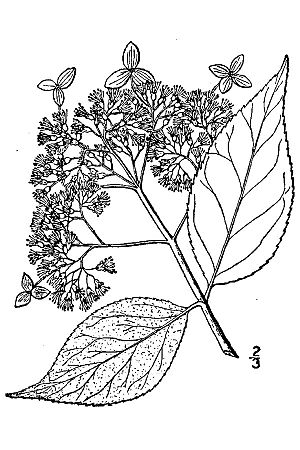Ashy hydrangea facts for kids
Quick facts for kids Ashy hydrangea |
|
|---|---|
 |
|
| Scientific classification | |
| Genus: |
Hydrangea
|
| Species: |
cinerea
|
| Synonyms | |
|
Hydrangea arborescens L. ssp. discolor (Walter) E.M. McClintock |
|
The ashy hydrangea (scientific name: Hydrangea cinerea) is a type of plant that grows as a small to medium-sized shrub. It can reach up to 3 meters (about 10 feet) tall. This plant is deciduous, which means its leaves fall off in the autumn.
You can find the ashy hydrangea growing naturally in the southeastern parts of the United States. Its common names, "ashy hydrangea" or "gray hydrangea," come from the gray look of the underside of its leaves. This gray color is caused by many tiny hairs, called trichomes, that cover the leaf surface.
Contents
Where Ashy Hydrangea Grows
The ashy hydrangea is found scattered across the southeastern United States. It prefers higher areas and rocky spots. You can see it in the southern parts of the Blue Ridge Mountains. Its range stretches from Tennessee to South Carolina, and west to Missouri. It also grows south into Arkansas, Alabama, and Georgia. This plant usually grows well in soils that are not too acidic, including neutral or lime-rich soils.
How Scientists Classify Ashy Hydrangea
The ashy hydrangea is closely related to other types of hydrangeas. It looks a lot like the smooth hydrangea (Hydrangea arborescens) and the silverleaf hydrangea (Hydrangea radiata). In the past, some scientists thought that ashy hydrangea and silverleaf hydrangea were just different types of smooth hydrangea. However, most plant scientists today agree that they are all separate species. This means they are distinct kinds of plants.
What Ashy Hydrangea Looks Like
Flowers and Blooms
The flowers of the ashy hydrangea grow in a cluster called a corymb. This is a flat-topped or rounded flower cluster. Most of the flowers are small and fertile, meaning they can produce seeds. Around the edge of the cluster, there are a few larger, showy flowers. These showy flowers are usually white or almost white. They are sterile, which means they do not produce seeds. These larger flowers are typically more than 1 centimeter (about 0.4 inches) wide. The ashy hydrangea blooms in late spring or early summer.
Leaves of the Plant
The leaves of the ashy hydrangea are quite large, usually 8 to 15 centimeters (about 3 to 6 inches) long. They grow in pairs directly across from each other on the stem. The edges of the leaves are serrated, meaning they have small, sharp teeth like a saw. The shape of the leaves is ovate, which means they are egg-shaped with the wider part at the bottom. As mentioned, the leaves are deciduous, falling off each year.
The underside of the leaves has many tiny hairs, or trichomes. These hairs make the leaves look gray. Even with these hairs, you can usually still see some green of the leaf surface underneath. If you look closely with a magnifying glass, you can see that these tiny hairs have small bumps, called tubercles.
Uses of Ashy Hydrangea
This beautiful native shrub is often grown in gardens for its attractive appearance. It is a good choice for landscaping. The ashy hydrangea can handle heat and dry conditions better than the silverleaf hydrangea. There are also special types of ashy hydrangea, called cultivars, that gardeners like. Some popular cultivars include 'Frosty', 'Pink Pin Cushion', and 'Sterilis'. These types have more of the showy, sterile flowers, making them even more decorative.
The Cherokee people have traditionally used the ashy hydrangea for medicinal purposes. For example, they would make a liquid medicine, called an infusion, from the scraped bark. They also used an infusion from the roots. It is believed that ashy hydrangea was used in similar ways to the smooth hydrangea by the Cherokee and early settlers. They used it to help with problems like kidney and bladder stones.
See also
 In Spanish: Hydrangea cinerea para niños
In Spanish: Hydrangea cinerea para niños

